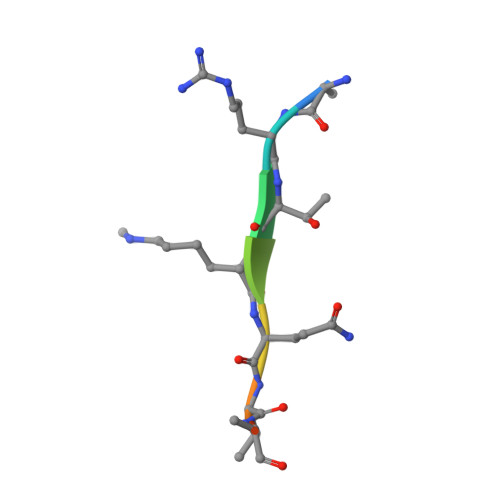Uncovering the mechanistic basis for specific recognition of monomethylated H3K4 by the CW domain ofArabidopsishistone methyltransferase SDG8.
Liu, Y., Huang, Y.(2018) J Biol Chem 293: 6470-6481
- PubMed: 29496997
- DOI: https://doi.org/10.1074/jbc.RA117.001390
- Primary Citation of Related Structures:
5YVX - PubMed Abstract:
Chromatin consists of DNA and histones, and specific histone modifications that determine chromatin structure and activity are regulated by three types of proteins, called writer, reader, and eraser. Histone reader proteins from vertebrates, vertebrate-infecting parasites, and higher plants possess a CW domain, which has been reported to read histone H3 lysine 4 (H3K4). The CW domain of Arabidopsis SDG8 (also called ASHH2), a histone H3 lysine 36 methyltransferase, preferentially binds monomethylated H3K4 (H3K4me1), unlike the mammalian CW domain protein, which binds trimethylated H3K4 (H3K4me3). However, the molecular basis of the selective binding by the CW domain of SDG8 (SDG8-CW) remains unclear. Here, we solved the 1.6-Å-resolution structure of SDG8-CW in complex with H3K4me1, which revealed that residues in the C-terminal α-helix of SDG8-CW determine binding specificity for low methylation levels at H3K4. Moreover, substitutions of key residues, specifically Ile-915 and Asn-916, converted SDG8-CW binding preference from H3K4me1 to H3K4me3. Sequence alignment and mutagenesis studies revealed that the CW domain of SDG725, the homolog of SDG8 in rice, shares the same binding preference with SDG8-CW, indicating that preference for low methylated H3K4 by the CW domain of ASHH2 homologs is conserved among higher-order plants. Our findings provide first structural insights into the molecular basis for specific recognition of monomethylated H3K4 by the H3K4me1 reader protein SDG8 from Arabidopsis .
Organizational Affiliation:
From the State Key Laboratory of Molecular Biology, National Center for Protein Science Shanghai, Shanghai Science Research Center, Shanghai Key Laboratory of Molecular Andrology, CAS Center for Excellence in Molecular Cell Science, Shanghai Institute of Biochemistry and Cell Biology, Chinese Academy of Sciences, University of Chinese Academy of Sciences, Shanghai 201210, China.

















